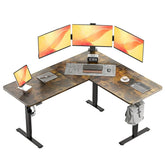Common Mistakes to Avoid When Using a Standing Desk
Using a standing desk is great for your health, but some mistakes can reduce the benefits or even cause discomfort. Knowing what to avoid helps you get the most from your standing desk and stay pain-free.
Standing Too Long Without Breaks
One common mistake is standing all day without sitting or moving. Standing for hours can cause tired legs, foot pain, and strain. It’s important to switch between sitting and standing every 30 to 60 minutes. Taking short walking breaks also helps reduce fatigue.
Incorrect Desk Height
Setting the desk too high or too low is a big problem. If your desk is too high, you might raise your shoulders and cause neck and shoulder pain. Too low, and you may have to hunch over, hurting your back. Adjust the desk so your elbows are at a 90-degree angle when typing.
Poor Monitor Placement
Placing your monitor too low or too high can cause neck strain. The top of your screen should be at or slightly below eye level. Your eyes should look straight ahead, not up or down. Use a monitor stand if needed to get the right height.

Not Using an Anti-Fatigue Mat
Standing on hard floors for long periods can cause discomfort and fatigue. Using an anti-fatigue mat helps reduce pressure on your feet and legs. It encourages small movements that improve blood flow and reduce soreness.
Wearing Unsupportive Shoes
Wearing shoes without good support can lead to foot pain and poor posture. Avoid high heels or hard-soled shoes when standing for long periods. Choose comfortable shoes with cushioning and arch support.
Ignoring Posture
Standing does not automatically mean good posture. Many people lean on one leg, lock their knees, or slouch while standing. Keep your weight evenly distributed, knees slightly bent, and shoulders relaxed. Stand tall and align your head with your spine.
Not Switching Positions
Some people stay in one position, either sitting or standing, for too long. It’s important to move and change positions regularly. This helps prevent stiffness and improves circulation.
Cluttered Workspace
A messy desk can cause awkward reaching or bending, leading to strain. Keep your workspace organized and items within easy reach to maintain good posture.
Ignoring Discomfort
If you feel pain or discomfort, don’t ignore it. Adjust your desk height, take breaks, or consult a professional if needed. Early changes can prevent long-term problems.
Not Adjusting to Your Body
Everyone’s body is different. Don’t copy someone else’s desk setup without adjusting for your height and comfort. Customize your desk, chair, and monitor to fit you.
Skipping Movement Breaks
Movement is key to staying healthy. Take short walks, stretch your legs, and change your standing position during the day. This keeps your muscles active and reduces fatigue.
Conclusion
Using a standing desk correctly takes practice. Avoiding these common mistakes will help you enjoy the benefits without pain or discomfort. Adjust your desk height, keep good posture, wear supportive shoes, and remember to take breaks. With these habits, a standing desk can improve your health and productivity.
Visit vvenace.com to view our full product range.



